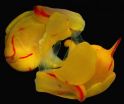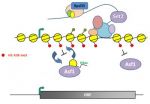(Press-News.org) Scientists at the University of Liverpool have found that the worm which causes River Blindness survives by using a bacterium to provide energy, as well as help 'trick' the body's immune system into thinking it is fighting a different kind of infection.
River Blindness affects 37 million people, mainly in sub-Saharan Africa, causing intense itching of the skin, visual impairment and in severe cases, irreversible blindness. It is caused by a parasitic worm that is transmitted by blood-feeding blackflies, which breed in fast-flowing rivers.
The team at Liverpool investigated a bacteria carried by the worm, called Wolbachia, which if removed by antibiotics, kills the adult worm and cures River Blindness. To understand why the worms need these bacteria to survive, scientists sequenced the genome of Wolbachia from a closely related parasite in cattle.
They found that the bacteria could provide the worm with energy through a process that needs iron and oxygen, similar to cell energy processes in the human body. The bacteria can also 'trick' the body's immune response into believing it is dealing with a bacterial rather than worm infection, making it difficult for the body to fight the disease.
Research findings could help target drugs at disabling the bacteria's energy-giving properties, which may provide shorter treatment regimes for River Blindness. Understanding the bacteria's ability to misdirect the human immune response could also contribute to work into vaccine development.
Dr Ben Makepeace, from the University of Liverpool's Institute of Infection and Global Health, said: "River Blindness is a major problem in tropical regions of Africa, where a similar parasite can also be found in cattle. Antibiotics have shown promise in critical trials, but treatment can be a long process for a patient, and so it is important for us to find new ways of combating the disease to improve patient welfare.
"It was a team at Liverpool that first discovered antibiotics could kill the bacteria inside these particular worms. The findings led us to believe that the bacteria played a crucial role in keeping the parasite alive. Sequencing the genome revealed that it could give the worm energy to survive and help 'fool' the host's immune response into believing it had to tackle a bacterial infection.
"We also studied, for the first time, which bacterial genes were switched on and off in different parts of the worm, and identified the kinds of proteins made by Wolbachia. We hope our research will contribute to shorter treatment programmes and potentially impact on the search for a vaccine."
###The study, in collaboration with the University of Edinburgh, the University of Poitiers, and the Institute of Agricultural Research for Development, Cameroon, is published in the journal, Genome Research.
Scientists reveal how river blindness worm thrives
2012-08-23
ELSE PRESS RELEASES FROM THIS DATE:
New climate history adds to understanding of recent Antarctic Peninsula warming
2012-08-23
Results published this week by a team of polar scientists from Britain, Australia and France adds a new dimension to our understanding of Antarctic Peninsula climate change and the likely causes of the break-up of its ice shelves.
The first comprehensive reconstruction of a 15,000 year climate history from an ice core collected from James Ross Island in the Antarctic Peninsula region is reported this week in the journal Nature. The scientists reveal that the rapid warming of this region over the last 100 -years has been unprecedented and came on top of a slower natural ...
Future memory
2012-08-23
A new class of organic materials developed at Northwestern University boasts a very attractive but elusive property: ferroelectricity. The crystalline materials also have a great memory, which could be very useful in computer and cellphone memory applications, including cloud computing.
A team of organic chemists discovered they could create very long crystals with desirable properties using just two small organic molecules that are extremely attracted to each other. The attraction between the two molecules causes them to self assemble into an ordered network -- order ...
Traumatic mating may offer fitness benefits for female sea slugs
2012-08-23
Female sea slugs mate more frequently than required to produce offspring, despite the highly traumatic and biologically costly nature of their copulation, as reported Aug. 22 in the open access journal PLOS ONE.
The authors of the study, led by Rolanda Lange of the University of Tuebingen in Germany, investigated the mating behavior of a simultaneously hermaphroditic species of sea slug that mates via an extravagant ritual that involves a syringe-like penile appendage that stabs the partner to inject prostate fluids and sperm.
Surprisingly, the researchers found that ...
Managerial role associated with more automatic decision-making
2012-08-23
Managers and non-managers show distinctly different brain activation patterns when making decisions, according to research published Aug. 22 in the open access journal PLOS ONE.
The authors of the study, led by Svenja Caspers of the Institute of Neuroscience and Medicine, Research Centre Jülich in Germany, used functional MR imaging to track the decision making process for managers and non-managers. Subjects were required to perform equally repetitive decisions, one form of decision making occurring in every-day work life. The authors found that manager and non-managers ...
Many medications for elderly are prescribed inappropriately
2012-08-23
Approximately one in five prescriptions to elderly people is inappropriate, according to a study published Aug. 22 in the open access journal PLOS ONE.
The authors of the study, led by Dedan Opondo of the Academic Medical Center in Amsterdam, conducted a systematic review of English-language studies of medication use in the elderly and found that the median rate of inappropriate prescriptions was 20.5%. Some of the medications with the highest rates of inappropriate use were the antihistamine diphenhydramine, the antidepressant amitriptyline, and the pain reliever propoxyphene.
INFORMATION:
Citation: ...
Parasitic wasps remember better if reward is greater
2012-08-23
Two parasitic wasp species show similar memory consolidation patterns in response to rewards of different quality, providing evidence that the reward value affects the type of memory that is consolidated. The full results are reported Aug. 22 in the open access journal PLOS ONE.
The researchers, led by Marjolein Kruidhof of the Netherlands Institute of Ecology, tested how wasps store scents associated with situations of low reward (egg-laying into a inferior-quality host species that lays single eggs) versus high reward (egg-laying into a superior-quality host species ...
Patients with anorexia judge own body size inaccurately, view others' accurately
2012-08-23
Patients with anorexia have trouble accurately judging their own body size, but not others', according to research published Aug. 22 in the open access journal PLOS ONE.
In the study, led by Dewi Guardia of the University Hospital of Lille in France, 25 patients with anorexia and 25 controls were shown a door-like aperture and asked to judge whether or not it was wide enough for them to pass through, or for another person present in the room to pass through. In previous similar experiments, anorexic patients felt they could not pass through the door even when it was easily ...
Ready. Get set. Repress!
2012-08-23
KANSAS CITY, MO—The first step in gene expression is the exact copying of a segment of DNA by the enzyme known as RNA polymerase II, or pol II, into a mirror image RNA. Scientists recognize that pol II does not transcribe RNA via a smooth glide down the DNA highway but instead encounters an obstacle course of DNA tightly wound around barrier proteins called histones. Those proteins must be shoved aside for pol II to trundle through.
Previous work from the lab of Jerry Workman, Ph.D., an investigator at the Stowers Institute for Medical Research, showed how a protein ...
Potency of statins linked to muscle side effects
2012-08-23
A study from the University of California, San Diego School of Medicine, published August 22 online by PLoS ONE, reports that muscle problems reported by patients taking statins were related to the strength or potency of the given cholesterol-lowering drugs.
Adverse effects such as muscle pain and weakness, reported to the U.S. Food and Drug Administration (FDA) were related to a statin's potency, or the degree by which it typically lowers cholesterol at commonly prescribed doses.
"These findings underscore that stronger statins bear higher risk – and should be used ...
University of East Anglia breakthrough boosts bacterial understanding
2012-08-23
Having healthy gut bacteria could have as much to do with a strategy that insurance companies use to uncover risk as with eating the right foods, according to researchers at the University of East Anglia (UEA).
Findings published today in Ecology Letters show how researchers applied a strategy used by insurance companies to understand how animals and plants recruit beneficial bacteria.
The breakthrough brings scientists closer to understanding the human body's relationship with bacteria, which account for nine cells out of every 10 in our bodies.
The research has ...

